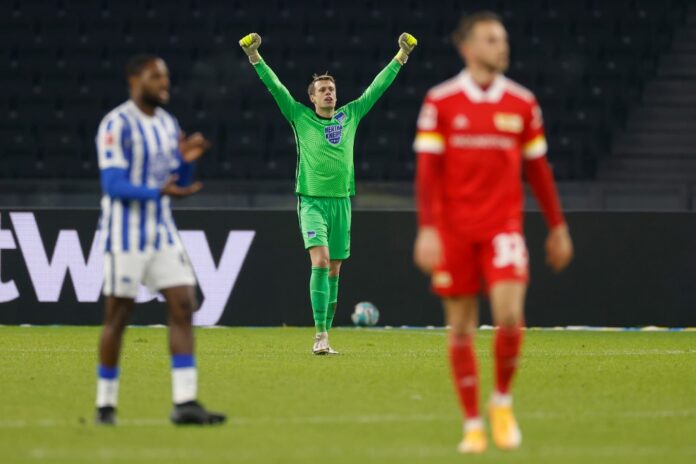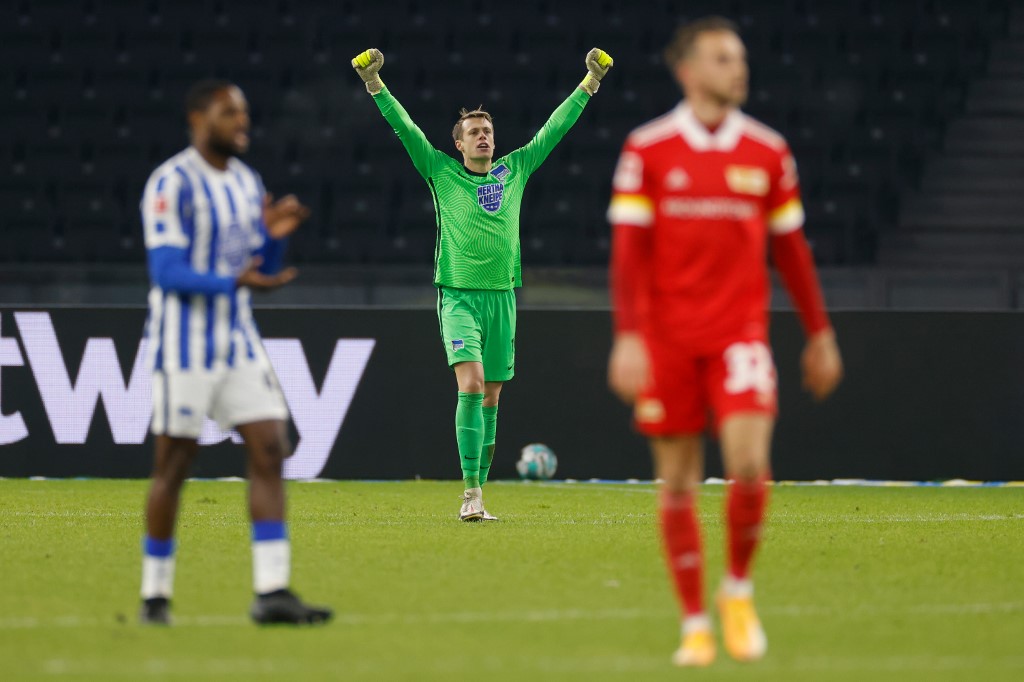

For football fans around the world, inter-city derbies are amongst the most exciting fixtures of any season. And Africa has plenty. Whether it’s Orlando Pirates v Kaizer Chiefs (South Africa), A.F.C. Leopards v Gor Mahia (Kenya), al Ahly v Zamalek (Eygpt), Yanga Vs Simba SC (Tanzania) or Asante Kotoko v Hearts of Oak (Ghana), Africa has some classics. But can any derby, anywhere, rival the Berlin derby for the sheer amount of human drama, tragedy, renewal and hope it has seen, over the years?
When Hertha BSC and 1. FC Union Berlin met last Friday (December 4) in the first of two all-Berlin match-ups this season, it could easily have been regarded by outsiders as a regular Bundesliga game. A lack of spectators due to COVID-19 restrictions might have added to that illusion. To Berliners and those in the know, however, the rivalry between these two clubs from the West and former East reflects a history of football in Berlin full of disruption and division – but also of solidarity.
In Bundesliga history there are many examples of derbies, such as the Hamburg derby or the Munich derby that already have that long tradition of special games and unique stories.
The roots of football in Berlin can be traced back as far as 1885, when clubs first began to officially form. One such club, BFC Germania 1888, still exists to this day and can proudly call itself the oldest football club in Germany.
Berlin was a hotspot for the development of organised football: when the German Football Association was founded in 1900, a large portion of the original member clubs were from the nation’s capital. Two such clubs exist and compete at the top level today: BFC Hertha 92 was founded in 1892 and later merged with Berliner Sport-Club to become Hertha BSC, while FC Olympia was established in 1906 before changing to 1. FC Union Berlin in 1966.
Global politics had a defining effect on Berlin football, perhaps more so than any other city in the world. With the construction of the Berlin Wall in 1961, the division of the city and its football landscape was literally set in stone – Hertha BSC competed in West Germany and eventually in the Bundesliga, while Union Berlin competed in the East German league.
However, the resilience and solidarity that enabled the Berliners to endure so many crises over the years also influenced the city’s football scene. Despite being divided by a wall, Hertha and Union fans still supported each other whenever it was possible.
Finally, in 1990, the Wall came down and Hertha and Union fans could come together. The derby between Hertha Berlin and Union Berlin remains an emotional event to this day.
However, compared to the emotions of those present at the game 30 years ago, when fans from both sides celebrated arm in arm, things are very different today. During the 2010-11 Bundesliga 2 season, the two teams faced each other for the first time ever in a competitive match. Played in Union’s freshly renovated Stadion An der Alten Försterei, the game ended in
a draw.
The next meeting was an unforgettable experience, at least from Union’s perspective. Playing away at a fully packed Olympiastadion, Union beat Hertha 2-1 and proceeded to paint the town red. Even though this could not stop Hertha topping the league by the end of the season, a true derby had emerged between the two teams.
Union spent another decade in the Bundesliga 2 and played against their rival again in the 2012/13 season when Hertha paid another visit to the second flight. In the 2019/20 season, with both clubs in the Bundesliga for the first time, the derby rose to a new level.
Until Friday, the competitive record between the two teams, whether that refers to games played in the Bundesliga or Bundesliga 2 was evenly balanced with two wins for both sides and two draws. Which made the outcome – and the wind by Hertha – even more significant.
So the unification of Germany and the harmonisation of East and West has paradoxically led to the very opposite in the Berlin football scene: a growing rivalry between Hertha and Union. Yet, this is a sign of the success and development of both clubs. 30 years after the German unification, it is finally time for Berlin to enjoy a regular derby devoid of political or historical baggage and simply played in the moment and in the spirit of the game.
FACT SHEET:
Though a new derby, the Berlin Derby is certainly not lacking in character and uniqueness.
The clash between the capital’s two top-flight teams brings together two sides with strong
identities. Here we share 20 facts on these two clubs to help you familiarise yourself with The
Old Lady on one side, and The Iron Ones on the other.
Hertha BSC
• Hertha Berlin is more than 125 years old and is the oldest football club in the
Bundesliga.
• Following its founding on 25th July 1892, the fledgling club took its name from the
blue-and-white steamship ‘Hertha’ which cruised along the Spree and Havel rivers.
One of the clubs’ founders, Fritz Lindner, had taken his father on a trip on the Upper
Spree on the Hertha some time before. A name change in 1923 saw BFC Hertha 92
merge with the Berliner Sport-Club to create Hertha BSC, commonly known as Hertha
Berlin.
• The club first made history in 1910 when Hertha 92 became the first continental
European club to beat a semi-professional English team (Southend United).
• In the 1920s the club reached the national championship final six times, before
winning it back-to-back years in both 1930 and 1931.
• From time in the Regionalliga (1965-68), to finishing runners-up in the top flight
(1974-75) and taking part in the Champions League (1999-2000), Hertha Berlin has
experienced many highs and lows since the establishment of the Bundesliga in 1963.
• Hertha Berlin’s stadium, the Olympiastadion, has a capacity of 74,475, making it the
third largest football stadium in Germany. It was the site of many historical events,
such as the 2006 FIFA World Cup Final between Italy and France, and is where Jesse
Owens won all four of his Olympic gold medals in 1936.
• Since celebrating its 125-year anniversary in 2017, the club has adopted the motto of
“The future belongs to Berlin”, a statement that reflects the uniqueness of Berlin and
the ever-evolving nature of the city.
• While the Hertha Berlin fans are sometimes known as ‘the Berliners’, they are also
often called ‘Die alte Dame’, or ‘The Old Lady’.
• “Ha-ho-he Hertha BSC!” is the customary chant of Hertha Berlin’s fans and can be
traced back to the 1927 season when 1,500 Hertha supporters were on their way to
an away game in Leipzig and invented the chant on the train platform.
• In the lead up to the Berlin Derby this year, the club has placed around 30,000 Hertha
Berlin flags all across Berlin to deliver the spirit of the derby to fans, despite the fact
they will not be able to attend the game at the stadium.
- FC Union Berlin
• 1. FC Union Berlin was founded under its current name on January 20, 1966 in the
German Democratic Republic, However, the club’s history can be traced back as far as
1906, when its predecessor, FC Olympia, was established.
• The club’s home ground is Stadion An der Alten Försterei, (the stadium at the old
forest warden’s office). The name comes from an old forester’s lodge adjacent to the
current ground, in which the club’s main offices are currently located.
• The stadium was officially opened on August 7, 1920, holds 22,012 fans (18,395
standing and 3,617 seats) and is the largest purpose-built football stadium in Berlin.
• During the 2008/2009 season the club’s fans rebuilt their own stadium, working on
the complete refurbishment and roofing of the standing areas. More than 2,300
volunteers provided 140,000 hours of labour time.
• 1. FC Union Berlin is often only called “Die Eisernen” (The Iron Ones) or “Eisern Union”
(The Iron Union) by its fans. “Eisern Union” – originally sung by the famous late
1970s/early 1980s “New German Wave” singer Nina Hagen – is also the name of the
club theme song.
• Union Berlin is known for its annual Christmas singing tradition. The tradition started
in 2003, when around 90 Union fans met for the first time in the stadium and sang
Christmas songs together. Many years later, its popularity has soared and the event
attracts around 28,000 participants each year.
• Although the Christmas singing tradition has been cancelled in 2020 due to COVID19, the club has prepared Christmas singing packages for fans to use at home. The
package contains the song book, a candle with drip protection, a lighter, a Christmas
cap and a scarf. Fans will be able to watch a recording of the 2019 Christmas singing
event on TV and sing along at home.
• Union made it to the topflight for the first time in the club’s history after defeating
VfB Stuttgart in the relegation play-offs in the 2018/19 season.
• In just their second season in the Bundesliga, 1. FC Union Berlin currently sit in sixth
place, and have only lost one match in their first nine fixtures for the season.
• So far this season Union Berlin has scored the second highest number of goals, (21),
and the second most penalties (four).


